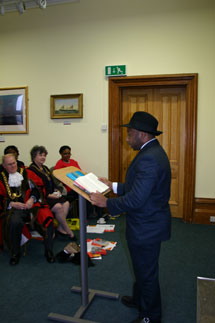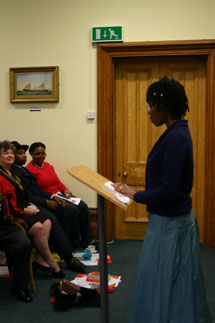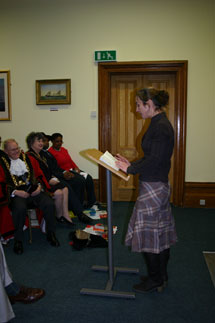|
|

The narration of Small
Island is shared between four characters:
Hortense Joseph (nee Roberts), her husband Gilbert, their landlady
Queenie Bligh (nee Buxton) and Queenie’s husband Bernard.
Andrea Levy has said of them:
It was very important to me that each of the four characters
had their own distinct voice. One of the reasons I enjoy writing
in the first person is that the process of writing a character
can become more like acting. I used to feel my way into the character
before I started writing and try to see everything that was happening
through their eyes. So for example with Hortense I would sit
up straight and imagine myself in white gloves and hear her voice
in my head. This sounds all very pretentious but it helped me
to understand the world from her point to view. Also when I write
I read back to myself aloud; to me, each of the characters had
a distinct way of speaking as well.
The Daily Telegraph critic described the book as being ‘written
in a plain, homely style, one that is keen for us to attend to
the subtle shifts and twists that its characters undergo’.
The reviewer went on to say: ‘Levy undercuts any assumption
that race alone defines them, and is keen to highlight those
symmetries and parallels in their life experiences.’
In its review, the Independent on Sunday said: ‘What makes
Levy’s writing so appealing is her even-handedness. All
her characters can be weak, hopeless, brave, good, bad – whatever
their colour.’
Hortense has grown up believing she is destined for a golden
life. She considers herself to be a cut above most of the other
islanders because she has skin ‘the colour of warm honey’,
is the daughter of Lovell Roberts (‘a man of class’),
has perfect diction and manners, and has been educated to be
a teacher. She has an early disappointment in Jamaica when she
can only get a job teaching the dark-skinned children of Half
Way Tree Parish School with their ‘wretched black faces’ rather
than the ‘polite, clean and well-spoken pupils’ from ‘good
families’ she had hoped for. However, it is her experience
of coming to Britain that is the biggest letdown. A reviewer
describes Hortense’s shock at the ugliness of racist Britain,
a place where her fair skin, white gloves and college education
count for nothing, as ‘both hilarious and woeful’,
making her ‘a character you love to hate — or, more
accurately, enjoy being exasperated by’. At first offended
by what she sees as the coarseness and ignorance of her husband,
by the end of the novel she has grown to love him. A reviewer
described this ‘slow development of Hortense’s respect
for her husband as she begins to understand the challenges he
faces’ as ‘one of the most moving aspects of the
book’.
Gilbert is a near look-alike of Michael Roberts, Hortense’s
adored cousin and Queenie’s lover. Hortense marries Gilbert
for convenience, as it means she will be able to go to Britain;
Queenie takes him in as a paying lodger and odd job man. However,
though the women may at first be disappointed that he is not
in the same class as the paragon that is Michael, through his
narration Gilbert proves to be a man of honour, humour, insight
and generosity. A privately educated son of a Christian convert,
Gilbert is a man who has quickly learnt to scale down his big
dreams to fit his circumstances. This has not been achieved without
some regret: his ideas soar so high above his lowly station he
can see them ‘lamenting and waving goodbye’. He may
seem a bit of a buffoon to Hortense, but he has hidden depths
and hidden strengths, which are gradually revealed to her once
she joins him in London.
Growing up, Queenie, like Hortense, believed she was destined
for a superior life. She was not like the dirty, common miners’ children
in the village, being the daughter of a butcher, and her ‘posh’ Aunt
Dorothy had taken her off to London so she could learn deportment
and elocution and thereby make a good marriage. Like Hortense,
too, Queenie soon learns there are limitations to what life can
offer her and, on her aunt’s death, marries the tedious
Bernard in order to remain in the city instead of returning home
to the ‘stinking’ farm. Queenie is warm-hearted and
gregarious, feeling sorry for the bombed-out East Enders who
are snubbed by her neighbours and taking in Jamaican lodgers
after the war, but she is also pragmatic, charging Gilbert and
his friends more than their rooms are worth. A reviewer said
that Queenie’s ‘cultural ignorance and insensitivity
are hard to ignore’, but added that unlike other characters
encountered in the book she was ‘More tactless than malicious’.
Bernard, like Gilbert, is a man who has returned from the war
to find the old world he knew has shrunk beyond recognition.
In an interview, Andrea Levy referred to him ‘coming back
and feeling a kind of redundancy’. It is this confusion
and feeling of inadequacy that gives his character a sympathetic
side, despite his racism and selfishness. He is a dull man with
irritating habits who rarely speaks and who had never done anything
interesting in his life until the war came. He hopes he might
become a hero and enjoys the camaraderie of being part of a team,
never realising that he is a figure of fun to the younger men
in his company.
|
|

Small Island paperback
cover (Headline).
Readings on launch day
in Bristol

Poet Edson Burton reading an extract narrated by Gilbert (Laura Thorne).

Valda Jackson of the artists' group Our Stories Make Waves reading
the part of Hortense (Laura Thorne).

Saskia Portway of Shakespeare at the Tobacco
Factory reading the part of Queenie (Laura Thorne). |
|